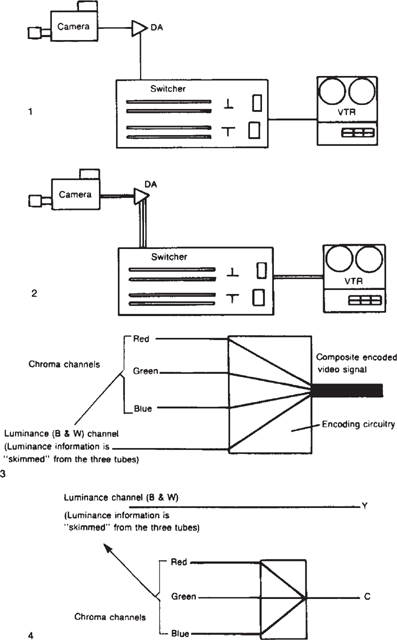A studio usually has one of several video signal systems.
Composite versus Component Video
Problems of Composite Video
You learned that encoding is the process of combining the three chrominance channels and the luminance channel into a single composite video signal. Many pieces of video equipment need to decode this composite signal into its component parts in order to process and use it. Of course, the component signals must then be re-encoded before the composite signal can be sent on its way from that piece of equipment. Every time the signal is encoded or decoded, it is distorted a little and some noise is added. As creative people want to use more sophisticated production techniques and consumers want a better picture, demands are being made for better quality video. There are a number of approaches to the problem.
Component Video
Taking the separate RGB outputs from each camera and running them directly to the switcher bypasses the entire encoding circuitry of the camera. This provides a cleaner, sharper picture. Keys come across especially well with this system. Of course, to get the most out of this system the entire studio needs to be component oriented — cameras, distribution amplifiers, switchers, and character generators. Upgrading a system to component requires reengineering the entire control room, since three cables will now have to be installed for every one that was there before.
Most equipment that originates video, such as cameras and character generators, is easily integrated into a component system. This equipment already generates RGB signals, so it doesn't take much to bypass the encoder. The DAs and switchers, however, are much more expensive. As a result, it is going to take a big budget to convert the entire studio to component video.
Y/C
A less expensive component system that produces higher quality video than composite video is Y/C. In technical terms, Y stands for the luminance information and C stands for the chrominance information. Using a Y/C (sometimes called S) system eliminates much of the encoding and decoding problems inherent in composite video.
To get an idea of how this system works, take a look at Y/C VTRs. Rather than laying down an entire field of composite video in one track, a Y/C must lay down the Y and C information separately to make a field. This provides much better quality at a reasonable cost.
1. Composite system.
2. Component system.
3. Composite video.
4. Y/C video.

